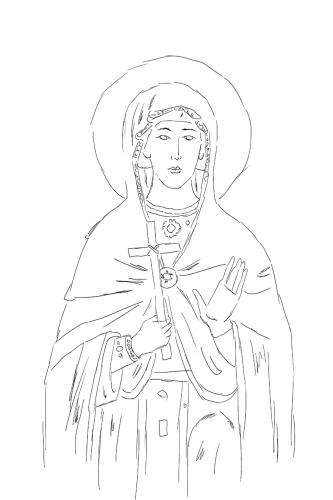



Saint Euphrasia (Eupraxia)
The hagiographic legend telling the life of Euphrasia, presents her as descendant of a high aristocratic family, related to Emperor Theodosius the Great, 4th. century. When she was only 7 years old, her recently widowed mother left Constantinople, together with her daughter, for Egypt, where she joined a feminine cenobitic community. Since her arrival in Egypt, young Euphrasia dedicated her life to Christ, entering a convent and renouncing her earthly wealth which she donated to the poor. The legend mentions a series of accidents and hurts suffered by Euprasia, as the devil tried in vain to make her turn away from her devotional duties. When she was about 30, Euphrasia died. Soon she was venerated for her ascetic exemplary life.
Iconographically, the representation of St. Euphrasia does not differ from those of other saints, mostly virgins dedicated to a severe monastic life. She is shown frontally, either full-length or half length, holding a cross in her right hand as a symbol of faith. She is clad in a dark colored mantle, covering her head and hiding her hair, signaling thus her monastic ascetic life. A specific frequently used detail is the presence of sumptuous courtly garments, visible under the mantle, proving her former social rank, wealth and privileges she had renounced in order to embrace the life of a nun in the desert.
The hagiographic legend telling the life of Euphrasia, presents her as descendant of a high aristocratic family, related to Emperor Theodosius the Great, 4th. century. When she was only 7 years old, her recently widowed mother left Constantinople, together with her daughter, for Egypt, where she joined a feminine cenobitic community. Since her arrival in Egypt, young Euphrasia dedicated her life to Christ, entering a convent and renouncing her earthly wealth which she donated to the poor. The legend mentions a series of accidents and hurts suffered by Euprasia, as the devil tried in vain to make her turn away from her devotional duties. When she was about 30, Euphrasia died. Soon she was venerated for her ascetic exemplary life.
Iconographically, the representation of St. Euphrasia does not differ from those of other saints, mostly virgins dedicated to a severe monastic life. She is shown frontally, either full-length or half length, holding a cross in her right hand as a symbol of faith. She is clad in a dark colored mantle, covering her head and hiding her hair, signaling thus her monastic ascetic life. A specific frequently used detail is the presence of sumptuous courtly garments, visible under the mantle, proving her former social rank, wealth and privileges she had renounced in order to embrace the life of a nun in the desert.




